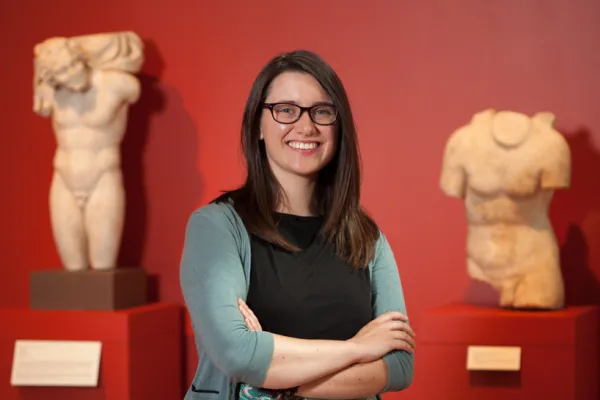Gallery Redesign at Smith Museum of Art Puts Collection in a New Light
Smith Arts

Published September 8, 2014
When asked to illustrate the results of a just-completed gallery reinstallation at the Smith College Museum of Art, Maggie Kurkoski ’12 heads straight for a new “Egyptian corner” of the Ancient Art gallery on the second floor.
Among her favorite objects is a New Year’s flask dating from 525 BCE that had previously been in storage.
“It has two baboon figures on either side of the spout that refer to Thoth, an Egyptian god who governed the New Year,” explained Kurkoski, a post-baccalaureate curatorial fellow who has been helping with the gallery redesign.
“It brings up the idea of the sacred and secular,” the new theme for artworks displayed on the second floor, Kurkoski said. “And it’s an item from our collection that people haven’t had a chance to see for a very long time.”
The museum’s first gallery reinstallation since the building opened in 2003 offers visitors new themes, new spaces and new ways of seeing objects in the permanent collection.
In addition to new paint and new lighting, display areas have been reorganized so that paintings, sculpture, antiquities and works on paper can be viewed from new angles—and in relationship to one another.
“Organized around historical themes and incorporating new research as well as new artworks, the rehanging embodies the museum’s mission to educate and engage through meaningful encounters with exceptional art.”
Museum Director Jessica Nicoll ’83 said the refurbished galleries offer visitors “a fresh and inviting look at SCMA’s collections spanning from antiquity to the mid-20th century.”
Galleries have been organized around new themes: “Sacred and Secular” for the second-floor displays of American, ancient and European art, and “Tradition and Transformation” for third floor galleries featuring African, American and European art after 1800.
Those themes provide new avenues for viewing artworks and for learning about items in the collection, Nicoll said.
“Organized around historical themes and incorporating new research as well as new artworks, the rehanging embodies the museum’s mission to educate and engage through meaningful encounters with exceptional art,” she noted.
As part of its free monthly Second Friday program, the museum will host a free “First Look” at the refurbished galleries on September 12 from 4 to 8 p.m. The event includes a “Hands-on!” art-making session starting at 4 p.m., an “Open Eyes” guided conversation about an art object in the reinstalled third-floor galleries at 6 p.m., and refreshments from the Tryon Common café. An artist from Northampton’s Chalk Art Festival will also be creating work outside the building.
“This is a great opportunity for Smith students to get to know their museum,” said Maggie Lind, associate director for academic programs and public education at the museum. “We hope they’ll come over—on their own or in a group—to do the art-making, have a snack, see the galleries and meet the staff.”
The new gallery offerings are the culmination of more than two years of work by museum staff and a reinstallation team, including lead curator Linda Muehlig, associate director for curatorial affairs and curator of painting and sculpture. Faculty members and students were also involved in discussions about gallery themes and new “encounter spaces” that let visitors respond to the collection in new ways.
A second phase of the reinstallation will begin in June 2015 in galleries on the museum’s first floor and lower level. Plans include creation of a dedicated gallery for the museum’s collection of Asian art, a New Media gallery and space for more hands-on activities.
Kurkoski, who spent much of the past year arranging artifacts in the Ancient Art gallery and writing new theme-oriented labels for the displays, said she’s excited about what lies in store for museum visitors.
“I think people are going to be surprised by how they’ll be able to see these objects in a new light,” said Kurkoski, who took part in the museums concentration program at Smith.
That’s as true for “old standby” favorites as it is for items that are newly out of storage, she emphasized.
As an example, Kurkoski pointed to a mosaic Bust of the Pyramos River from 2nd-century Antioch—a favorite of many museumgoers—that is now set off by deep red gallery walls and a new label describing how it illustrates sacred and secular ideas.
“I’m excited for people to see what we’ve done,” Kurkoski said. “Our collection has a lot to say.”
Maggie Kurkoski ’12, a curatorial fellow at SCMA, has been involved with the redesign of the Ancient Art gallery. Photo by Lynne Graves.